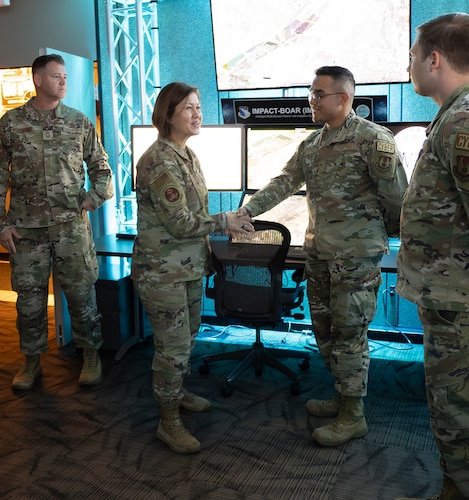Chief Master Sgt. of the Air Force JoAnne Bass visited multiple Wright-Patterson Air Force Base facilities, including the Air Force Research Laboratory's 711th Human Performance Wing Nov. 9.
"We're super excited to spend some time with you," Bass said. "When I talk about building the Force of the Future, the work AFRL is doing is essential."
During Bass's visit to the 711 HPW, she was briefed by multiple subject matter experts on the Base Oversight of Autonomous Response, or BOAR, program and how it ties into the Readiness Airman Training, which is a part of the new Air Force Force Generation, or AFFORGEN, deployment model. The BOAR program aims to revolutionize infrastructure, processes and policies to field integrated capabilities that are reliable, safe and maximize autonomy and human-machine-teamed operations for installation mission support.
AFFORGEN is the new deployment model used by the Air Force and will incorporate drone training as part of the Readiness Airman Training, which is a prerequisite for deploying under the AFFORGEN model, said Chief Master Sgt. Doug Middendorf, 88th Communications Squadron senior enlisted leader.
"We have teamed up with AFRL to actually create a drone program for the [711 HPW]," Middendorf said. "Many of the Airmen are from the 88th Communications Squadron who have learned how to fly drones, set up the mission planning cell, and also to set up to move forward."
The proof of concept, which debuted during the Air Force Marathon, will be used for Airman Readiness Training, Middendorf said.
"This is the first time, though, that I'm meeting our cyber Airmen who were flying drones because typically it's our Defenders," Bass said. "If you could fly a drone or do your cyber job, what would you do?"
During her visit, Bass posed the question to Senior Airman Geoffrey Alvarado, autonomous drone operations specialist, 88th Communications Squadron, about whether he enjoys flying drones or performing cyber-related work.
Alvarado said he has enjoyed doing both.
"We started off as a four-member team about five months ago," Alvarado said. "We've been trying to integrate with this project as much as we can. It has been a big step going from [communication] to flying drones."
Alvarado said the team members have been relying on their own experiences to learn about the Air Force to create new ideas, such as a drone operations center.
"We've mostly been trying to integrate with how the rest of the Air Force does its airspace missions and implementing it into this and trying to make a system that can go across the entire force," Alvarado said.
Bass said the Air Force is looking to define its mission sets.
"There was an article we read before the pandemic that talked about how … every Army infantryman is starting to learn how to do this, because it will, at some point, be part of their competencies," Bass added. "As we look at what an Airman of the future looks like, we have to ask ourselves: does every Airman - to some degree - have a similar level of competency?"
Alvarado said the team is looking to provide as much education on the system as possible before a deployment.
"We are putting that in our familiarization training for Readiness Airman Training in support of the AFFORGEN deployment process for them to have familiarization of what a drone looks like, what its capabilities are," Alvarado said. "So, the first time they see it downrange, it's not the first time they're seeing it."







